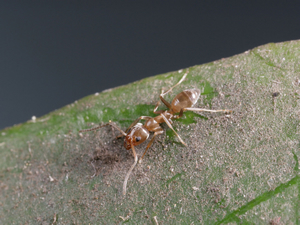
Image – Richard Toft ©Entecol
Detection of Argentine Ants
The detection of Argentine ants at low densities is a critical issue for effective management of this pest, as failure to detect (and thus control) may have considerable flow-on effects in terms of pest density, spread, and long-term persistence (Stanley et al. 2008).
Early detection in surveillance programmes may give a greater chance of successful containment or eradication, and where eradication is attempted, aid targeted ongoing treatment and enhance the ability to determine if it has been successful.
In New Zealand, there are several examples where the early detection of Argentine ants has most likely prevented further spread (Harris 2002). For example, early detection of Argentine ants at the Northland Department of Conservation Field Centre allowed for their control and significantly reduced the chances of Argentine ants being transported via the field store to offshore islands (C. Green pers. comm.).
Detection probability
Finding big infestations is easy! Finding small nests (either that have survived post-control or new nests in an area) is extremely difficult. This becomes an issue of detection probability. This problem occurs across pests, weeds, post-border, pre-border, and is also an issue for finding rare species of conservation concern.
Detection probability is particularly an issue for ants because of their small size (they are easily overlooked), and they are extremely difficult to eradicate once well established
Once a surveillance or monitoring activity has been completed and no Argentine ants were found, the question needs to be asked “were they really not there, or did we just miss them?”
Ways to reduce the chances of missing Argentine ants include:
- Looking at the ‘right time’
- Looking in different microhabitats
- Using different sampling techniques
- Repeating the number of visits to the same location
Essentially this means ‘more and more sampling’. Obviously there is a point where resources are limited and the extent of sampling becomes unreasonable.
The science of detection probabilities can be used to determine:
- Confidence around a certain amount of sampling (sampling effort)
- Effectiveness of different sampling techniques, and how they could best be combined to maximise the chances of finding Argentine ants, while reducing surveying costs and time.
However, this has not been used for Argentine ants, either in New Zealand or elsewhere.
